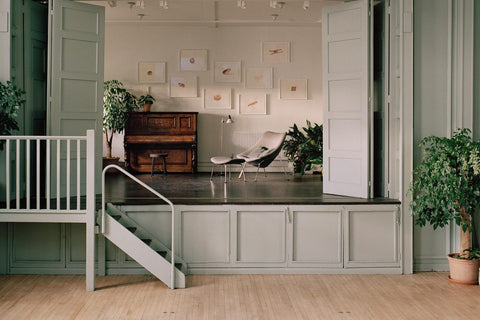“IF YOU HAVE THE ENERGY OF MASSIMO AND OUR TEAM, IT’S LIKE A KIND OF MAGIC. OUR INTEREST IS TO MAKE SPACES THAT MAKE PEOPLE HAPPY.”

There’s a powerful synergy to Refettorio Felix: the energy and drive of chef Massimo Bottura, the empathy of designer Ilse Crawford, and the tireless conviction of The Felix Project. But, as with most powerful ideas, the end result adds up to even more than its individual components. As Bottura puts it: “London is a city full of challenges and inequalities. Food waste is rampant. There are growing concerns about food poverty and social isolation. Refettorio Felix is not just a place where people come to eat a meal. It is a place for inclusion, engagement, and sharing, where everyone can feel welcomed and be inspired.”

Bottura’s idea to serve food to those in need using surplus ingredients is one of those accidents which turned into a powerful doctrine for life. In 2015, the celebrated Italian chef put his three Michelin stars to radical use by opening a temporary soup kitchen in Milan called Refettorio Ambrosiano. The idea was to highlight food surplus and waste, while feeding the vulnerable. The only thing that’s changed about the project’s mantra is that it’s no longer temporary, and it has taken off worldwide. Bottura says that the moment he realised that he’d created something unstoppable was when one of his chef friends visited the Refettorio Ambrosiano. “René Rezdepi came to cook in Milan, and he said: ‘You know Massimo, this is for life.’ And yes, he was right.” Bottura and his wife Lara founded Food for Soul with the aim of taking their vision of good food, cooked well, and set about fighting food waste and feeding the hungry anywhere in the world that wanted their help. “In 2016, we built Refettorio Gastromotiva in Rio de Janeiro during the Olympics. Soup kitchens were closed to hide the so-called ‘ugly’ side of the city from the spotlight of such an important occasion. So, we decided to open our community kitchen.” It’s a typical Bottura gesture – those in charge wanted to hide poverty and deprivation, he wanted to highlight it.
Refettorio Felix opened at St Cuthbert’s in Kensington, London this year, serving lunch to around 100 people a day. First, the space had to be transformed from what had been a functional, slightly dismal community space. This is where designer and creative director Ilse Crawford of Studioilse came in. She worked pro bono, and persuaded furniture and design companies to donate their chairs, tables, furnishings, cutlery, and glasses. St Cuthbert’s now has that uncanny air of a place that looks familiar, yet entirely different. The walls are a darker, more calming shade, the lighting more soothing, the plants plentiful.

Crawford, revered by many in her profession, doesn’t talk like any designer I’ve ever met. In her opinion, it isn’t about how a design looks, but rather about what it does. “Design is not an aesthetic,” she argues. “It’s a methodology that allows you to find the right answer. Staying the same is never the right answer.” It’s a powerful mantra, and one which fits Bottura’s vision entirely. As Crawford says: “If you have the energy of Massimo and our team, it’s like a kind of magic. Our interest is to make spaces that make people happy.” Crawford, who’s also head of the Man and Wellbeing design course at Eindhoven University, has created a mind map of provocative words for her students, which uses phrases such as ‘the fight to be human’, ‘things that last’, ‘make the normal special’, ‘together through food’, and ‘we are the system’, all of which, perhaps not surprisingly, suit Refettorio Felix perfectly. She also, against expectations, likes the idea that people might appropriate her ideas. “You have to be prepared to be copied if you want to make an impact,” she says. “We have to let go of the idea that we are the only people that can do it. It’s about creating the framework. We often try to do too much, but if you create a frame, people can fill it. There’s no shortage of people who want to help, if the system is there. I’m optimistic and pragmatic. Someone has to do it, start it – Massimo has started the thing. He’s doing it in a viral way, and he wants
people to copy him.”

The third, vital part of Refettorio Felix is, of course, Felix himself. Felix Byam Shaw was only 14 years old when he died suddenly from meningitis in 2014. He was a remarkable boy whom his friends and family adored. Ask anyone who knew him, and they all say the same thing: he was full of kindness and compassion for others. The Felix Project was founded to celebrate those qualities, and now a fleet of Felix vans, driven by volunteers, collects surplus food from supermarkets each morning and delivers it to centres for the homeless and vulnerable. Refettorio Felix is one of those places.
If there’s one gesture that embodies everything that Bottura, Crawford, and The Felix Project try to do, it’s that those who eat at Refettorio Felix have their food brought to them at the table. Bottura puts it like this: “Our guests include both the homeless, and individuals and families in situations of food poverty, food insecurity, and social vulnerability. By using quality tableware and restaurant style service, we want to make each guest feel valued and bring a sense of dignity back to the table.” His conviction that people should not have to queue for their food, but rather be served, came to him when he opened the original refettorio in Milan. “I still remember the very first nights there, when people were silently sitting at the table and eating their meals. A couple of guests barely spoke to each other. But a few weeks later, every night was a huge party; guests, volunteers, and chefs were sharing the same table and the same meal. We knew each other by name. Hospitality can lead to social inclusion through the simple gesture of serving meals at the table and saying, ‘Hi, how was the soup?’”

On the day that Refettorio Felix opened, Bottura himself cooked, and fittingly, began with soup. “It was a great responsibility. We served a soup that I called ‘Soup of Everything’, because it was the result of many different vegetables enriched with a broth made from Parmigiano Reggiano cheese rinds. Then we served pasta with pesto sauce, made with humble breadcrumbs instead of pine nuts; and finally, we served an Earl-Grey-tea-and-biscuits ice cream to honour the wonderful food culture of the UK. But this meal is only one example among many others created by the chefs and the resident kitchen team following the same principles — it is healthy and nutritious; it is seasonal, thanks to the products that The Felix Project delivers to our door every morning; it is made by recovering food surplus; it is genuine and heart warming; and it is delicious.” In many ways, that first meal sums up this remarkable venture by bringing together passionate volunteers who are trying to make things better for others, whilst honouring the legacy of a boy everyone loved. It really is a ‘Soup of Everything’.
- WORDS: Charlie Lee-Potter
- PHOTO: Rory Gardiner
- ORIGINAL POST: Readcereal

